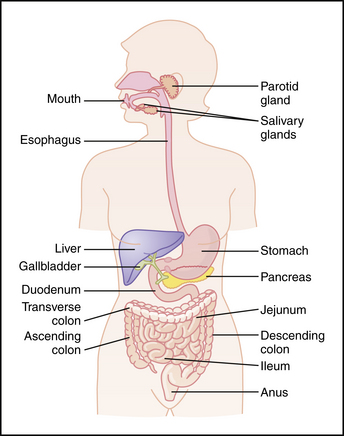57 CASE 57
PATHOPHYSIOLOGY OF KEY SYMPTOMS
The gastrointestinal tract is an epithelium-lined tube that passes through the body from the mouth to the anus. It consists of the mouth (and salivary glands), pharynx, esophagus, stomach, small intestine, large intestine, rectum, and anus (Fig. 57-1). Along this tract, digestion and absorption of nutrients takes place. Various exocrine glands and cells secrete about 7 L of fluid into the gastrointestinal tract per day. Ingested food first passes through the esophagus into the stomach where it is mixed with acid and enzymes to create chyme. The chyme passes into the small intestine, where most digestion and nearly all absorption takes place. The epithelial mucosal layer of the small intestine is covered in villi to increase the surface area available for absorption (Fig. 57-2). From the small intestine, only approximately 1.5 L/day of watery chyme passes into the large intestine, where water and electrolytes are absorbed, leaving semisolid feces to be propelled into the rectum and then to exit the body via the anus.
< div class='tao-gold-member'>
Stay updated, free articles. Join our Telegram channel

Full access? Get Clinical Tree



